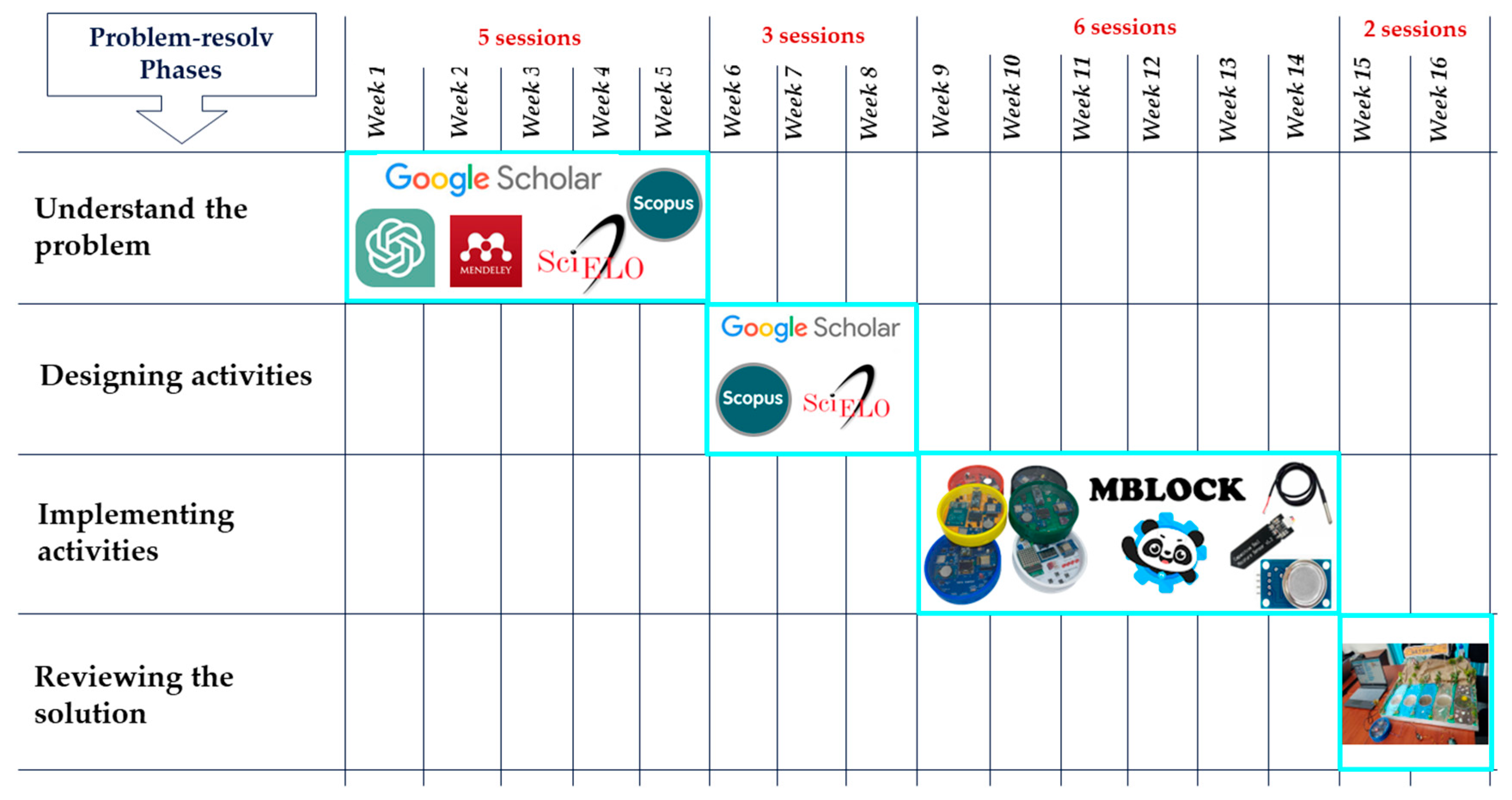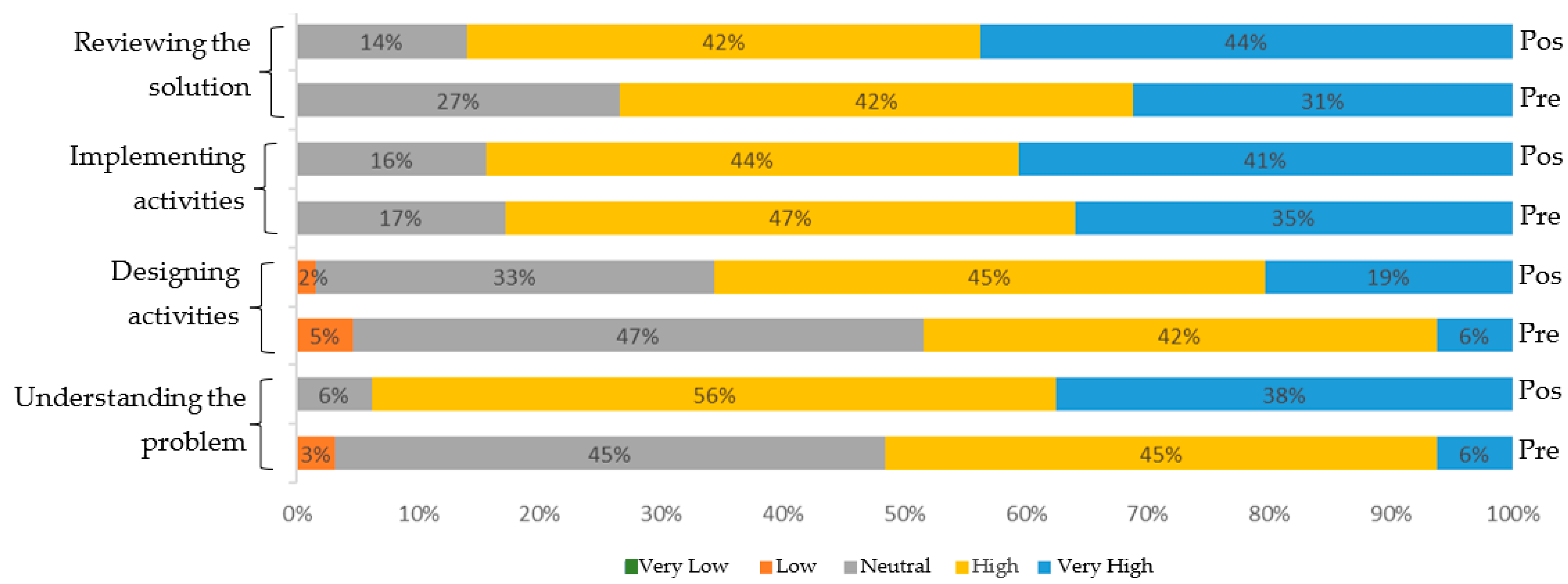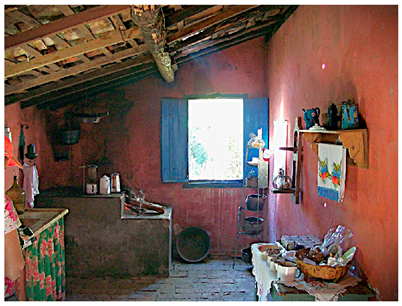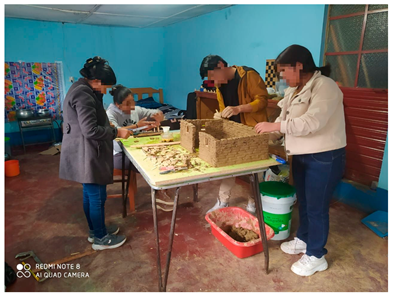Promoting Sustainable Research Competence Through a Problem-Solving Method and a STEM Educational Kit: A Case Study with Nursing Students at a Newly Established Public University in Peru
Abstract
1. Introduction
2. Literature Review
2.1. Formative Research
2.2. Strengthening Research Competencies Through Problem Solving
2.3. Problem-Solving Method Based on Pólya’s Proposal
2.4. STEM Educational Electronic Kit
2.5. Educational Sustainability in Health Sciences
3. Materials and Methods
3.1. Research Approach and Participants
3.2. Proposal and Implementation of Formative Research Projects in the Classroom
3.2.1. Formative Research Projects and the STEM Educational Kit
3.2.2. Development of Research Activities in the Classroom
4. Results
4.1. Descriptive Evaluation of Research Competence According to the Problem-Solving Phases
4.2. Hypothesis Testing of Research Competence According to the Phases of the Problem-Solving Method
4.3. Analysis of Research Competence Development According to the Problem-Solving Phases
5. Discussion
6. Conclusions
Author Contributions
Funding
Institutional Review Board Statement
Informed Consent Statement
Data Availability Statement
Conflicts of Interest
References
- Espinoza, E.E. La investigación formativa. Una reflexión teórica. Rev. Conrado 2020, 16, 45–53. [Google Scholar]
- Turpo-Gebera, O.; Quispe, P.M.; Paz, L.C.; Gonzales-Miñán, M. Formative research at the university: Meanings conferred by faculty at an Education Department. Educ. Pesqui. 2020, 46, 1–18. [Google Scholar] [CrossRef]
- Rivas, L.; Loli, R.; Quiroz, M. Percepción de estudiantes de enfermería sobre la investigación formativa en pregrado. ECIMED 2020, 3, 1–15. Available online: https://revenfermeria.sld.cu/index.php/enf/article/view/3486 (accessed on 10 June 2025).
- Hernández, A.; Illesca-Pretty, M.; Hein-Campana, K.; Godoy-Pozo, J. Percepción del estudiante de enfermería sobre investigación formativa Perception of nursing students about formative research. AMC 2020, 6, 774–785. [Google Scholar]
- Llanos de Tarazona, M. Uso de tecnologías de información y comunicación y habilidades investigativas en estudiantes de enfermería. Rev. Peru. Cienc. Salud 2019, 1, 185–190. [Google Scholar] [CrossRef]
- Sterling, S. Sustainable Education—Re-Visioning Learning and Change; Green Books: Newark, NJ, USA, 2001. [Google Scholar]
- UNESCO Education for Sustainable Development: A Roadmap; UNESCO: París, France, 2020. [CrossRef]
- Portillo, N. El Aprendizaje Servicio, la Educación para el Desarrollo Sostenible y las Competencias Transversales, una vía Hacia Sociedades Sostenibles. 2018. Available online: http://hdl.handle.net/10433/6323 (accessed on 12 April 2025).
- UNESCO. Descifrar el Código: La Educación de las Niñas y las Mujeres en Ciencias, Tecnología, Ingeniería y Matemáticas (STEM). 2019. Available online: https://unesdoc.unesco.org/ark:/48223/pf0000366649?posInSet=1&queryId=d5f381da-86f6-442b-8f3b-a86a83220043 (accessed on 6 March 2025).
- United Nations Transforming Our World: The 2030 Agenda for Sustainable Development. Available online: https://sdgs.un.org/2030agenda (accessed on 19 June 2025).
- Paucar-Curasma, R.; Villalba-Condori, K.O.; Mamani-Calcina, J.; Rondon, D.; Berrios-Espezúa, M.G.; Acra-Despradel, C. Use of Technological Resources for the Development of Computational Thinking Following the Steps of Solving Problems in Engineering Students Recently Entering College. Educ. Sci. 2023, 13, 279. [Google Scholar] [CrossRef]
- Paucar-Curasma, R.; Villalba Condori, K.O.; Unsihuay Tovar, R.F.; Arias Chavez, D.; Gonzales Agama, S.H.; Ureta Orihuela, F.L. Visual Programming and Problem-Solving To Foster A Positive Attitude Towards Formative Research. Vis. Rev. 2025, 17, 111–126. [Google Scholar]
- Paucar-Curasma, R.; Villalba-Condori, K.O.; Gonzales-Agama, S.H.; Huayta-Meza, F.T.; Rondon, D.; Sapallanay-Gomez, N.N. Technological Resources and Problem-Solving Methods to Foster a Positive Attitude Toward Formative Research in Engineering Students. Educ. Sci. 2024, 14, 1397. [Google Scholar] [CrossRef]
- PROCIENCIA-CONCYTEC Investigadores de Huancavelica Desarrollan Dispositivo Educativo para Facilitar Aprendizaje Sencillo para Universitarios—Noticias—Programa Nacional de Investigación Científica y Estudios Avanzados—Plataforma del Estado Peruano. Available online: https://www.gob.pe/institucion/prociencia/noticias/919234 (accessed on 19 June 2025).
- Paucar-Curasma, R.; Cerna-Ruiz, L.P.; Acra-Despradel, C.; Villalba-Condori, K.O.; Massa-Palacios, L.A.; Olivera-Chura, A.; Esteban-Robladillo, I. Development of Computational Thinking through STEM Activities for the Promotion of Gender Equality. Sustainability 2023, 15, 12335. [Google Scholar] [CrossRef]
- Boakye, D.S.; Kwashie, A.A.; Adjorlolo, S.; Korsah, K.A. Nursing Education for Sustainable Development: A Concept Analysis. Nurs. Open 2024, 11, e70058. [Google Scholar] [CrossRef]
- Lapa-Asto, U.; Tirado-Mendoza, G.; Roman-Gonzalez, A. Impact of Formative Research on Engineering students. In Proceedings of the 2019 IEEE World Conference on Engineering Education (EDUNINE), Lima, Peru, 17–20 March 2019. [Google Scholar]
- Alvarado, F.; Villar-Mayuntupa, G.; Roman-Gonzalez, A. The formative research in the development of reading and writing skills and their impact on the development of indexed publications by engineering students. In Proceedings of the 2020 IEEE World Conference on Engineering Education (EDUNINE), Bogota, Colombia, 15–18 March 2020. [Google Scholar]
- Zúñiga-Cueva, J.; Vidal-Duarte, E.; Padrón Alvarez, A. Methodological Strategy for the Development of Research Skills in Engineering Students: A Proposal and its Results. In Proceedings of the International Conference on Industrial Engineering and Operations Management, San Paulo, Brazil, 5–8 April 2021; pp. 2525–2536. [Google Scholar]
- Llulluy-Nuñez, D.; Luis Neglia, F.V.; Vilchez-Sandoval, J.; Sotomayor-Beltrán, C.; Andrade-Arenas, L.; Meneses-Claudio, B. The impact of the work of junior researchers and research professors on the improvement of the research competences of Engineering students at a University in North Lima. In Proceedings of the LACCEI international Multi-conference for Engineering, Education and Technology, Virtual, 19–23 July 2021; Latin American and Caribbean Consortium of Engineering Institutions: Boca Raton, FL, USA, 2021. [Google Scholar] [CrossRef]
- Sánchez Carlessi, H.H. La Investigación Formativa En La Actividad Curricular. Rev. Fac. Med. Humana 2017, 17, 71–74. [Google Scholar] [CrossRef]
- Paucar-Curasma, R.; Frango, I.; Rondon, D.; López, Z.; Porras-Ccancce, L. Analysis of the Teaching of Programming and Evaluation of Computational Thinking in Recently Admitted Students at a Public University in the Andean Region of Peru Ronald. In Proceedings of the Congreso Internacional de Tecnología e Innovación Educativa, Arequipa, Peru, 8–10 November 2022; p. 10. [Google Scholar]
- Yucra-Camposano, J. Strengthening research competencies: A systematic review of strategies used in higher education. Chakiñan Rev. Cienc. Soc. Humanidades 2023, 21, 210–228. [Google Scholar] [CrossRef]
- Pozuelo-Muñoz, J.; Calvo-Zueco, E.; Sánchez-Sánchez, E.; Cascarosa-Salillas, E. Science Skills Development through Problem-Based Learning in Secondary Education. Educ. Sci. 2023, 13, 1096. [Google Scholar] [CrossRef]
- Mayer, R.E.; Wittrock, M.C. Problem solving. In Handbook of Educational Psychology; Routledge: New York, NY, USA, 2006. [Google Scholar]
- Suárez, S.; Espinoza, S. Effectiveness of problem-based learning in the academic performance of the physics course. In Proceedings of the 16th LACCEI International Multi-Conference for Engineering, Education and Technology, Lima, Peru, 18–20 July 2018. [Google Scholar] [CrossRef][Green Version]
- Surif, J.; Hasniza Ibrahim, N.; Mokhtar, M. Conceptual and Procedural Knowledge in Problem Solving. Procedia—Soc. Behav. Sci. 2012, 56, 416–425. [Google Scholar] [CrossRef]
- Willemsen, R.H.; de Vink, I.C.; Kroesbergen, E.H.; Lazonder, A.W. Strengthening Creative Problem-Solving within Upper-Elementary Science Education. J. Creat. Behav. 2024, 58, 137–150. [Google Scholar] [CrossRef]
- Vilcapoma, K. Competencias Investigativas y la Resolución de Problemas en Internos de la Facultad de Medicina en una Universidad Pública de Lima. Master’s Thesis, Universidad Peruana Cayetano Heredia, Lima, Peru, 2022. [Google Scholar][Green Version]
- Lozano-Ramírez, M.C. El aprendizaje basado en problemas en estudiantes universitarios. Tend. Pedagógicas 2020, 37, 90–103. [Google Scholar] [CrossRef]
- Arbeu-Reyes, E.; Torquemada-González, A.; Orozco-Ramírez, L. For the development of investigative skills through the use of digital tools: Mendeley and Obsidian. Rev. Transdiscipl. Estud. Soc. Tecnológicos 2024, 4, 33–41. [Google Scholar] [CrossRef]
- Allison, M.; Joo, S. Revisiting Polya’s Approach to Foster Problem Solving Skill Development in Software Engineers. In Proceedings of the 9th International Conference on Computer Science & Education (ICCSE 2014), Vancouver, BC, Canada, 22–24 August 2014; pp. 379–384. [Google Scholar] [CrossRef]
- Chacón-Castro, M.; Buele, J.; López-Rueda, A.D.; Jadán-Guerrero, J. Pólya’s Methodology for Strengthening Problem-Solving Skills in Differential Equations: A Case Study in Colombia. Computers 2023, 12, 239. [Google Scholar] [CrossRef]
- Molina, Á.; Adamuz, N.; Bracho, R. La resolución de problemas basada en el método de Polya usando el pensamiento computacional y Scratch con estudiantes de Educación Secundaria. Aula Abierta 2020, 49, 287–303. [Google Scholar] [CrossRef]
- Jahudin, J.; Siew, N.M. The effects of polya’s problem solving with digital bar model on the algebraic thinking skills of seventh graders. Probl. Educ. 21st Century 2024, 82, 390–409. [Google Scholar] [CrossRef]
- Ortega-Ruipérez, B. Pedagogía del Pensamiento Computacional desde la Psicología: Un Pensamiento para Resolver Problemas. Cuest. Pedagógicas 2020, 2, 130–144. [Google Scholar] [CrossRef]
- Pólya, G. How to Solve It, 2nd ed.; Doubleday Anchor Books; Princeton University Press: New York, NY, USA, 1945. [Google Scholar]
- Paucar-Curasma, R.; Villalba-Condori, K.O.; Viterbo, S.C.F.; Nolan, J.J.; Florentino, U.T.R.; Rondon, D. Fomento del pensamiento computacional a través de la resolución de problemas en estudiantes de ingeniería de reciente ingreso en una universidad pública de la región andina del Perú. RISTI—Rev. Ibérica Sist. Tecnol. Informação 2022, 48, 23–40. [Google Scholar] [CrossRef]
- Ortega, B.; Asensio, M. Evaluar el Pensamiento Computacional mediante Resolución de Problemas: Validación de un Instrumento de Evaluación. Rev. Iberoam. Evaluación Educ. 2021, 14, 153–171. [Google Scholar] [CrossRef]
- Fronza, I.; Corral, L.; Pahl, C. Combining block-based programming and hardware prototyping to foster computational thinking. In Proceedings of the SIGITE 2019—Proceedings of the 20th Annual Conference on Information Technology Education, Tacoma, WA, USA, 3–5 October 2019; pp. 55–60. [Google Scholar] [CrossRef]
- Wang, M.-T.; Degol, J.L. Gender Gap in Science, Technology, Engineering, and Mathematics (STEM): Current Knowledge, Implications for Practice, Policy, and Future Directions. Educ. Psychol. Rev. 2017, 29, 119–140. [Google Scholar] [CrossRef] [PubMed]
- Maass, K.; Geiger, V.; Romero, M.; Goos, M. The Role of Mathematics in interdisciplinary STEM education. ZDM—Math. Educ. 2019, 51, 869–884. [Google Scholar] [CrossRef]
- Capraro, R.; Slough, S. STEM Project-Based Learning: An Integrated Science, Technology, Engineering, and Mathematics (STEM) Approach; Sense Publishers: Rotterdam, The Netherlands, 2013; pp. 1–5. [Google Scholar]
- Thibaut, L.; De Loof, H.; De Meester, J.; Goovaerts, L. Integrated STEM Education: A Systematic Review of Instructional Practices in Secondary Education. Eur. J. STEM Educ. 2018, 3, 2. [Google Scholar] [CrossRef]
- Iversen, O.S.; Smith, R.C.; Dindler, C. From Computational Thinking to Computational Empowerment: A 21st Century PD Agenda. In Proceedings of the PDC ’18: Proceedings of the 15th Participatory Design Conference, Hasselt and Genk, Belgium, 20–24 August 2018. [Google Scholar] [CrossRef]
- Fidai, A.; Capraro, M.M.; Capraro, R.M. ‘Scratch’-ing computational thinking with Arduino: A meta-analysis. Think. Ski. Creat. 2020, 38, 100726. [Google Scholar] [CrossRef]
- Melo, J.; Fidelis, M.; Alves, S.; Freitas, U.; Dantas, R. A comprheensive review of Visual Programming Tools for Arduino. In Proceedings of the 2020 Latin American Robotics Symposium, 2020 Brazilian Symposium on Robotics and 2020 Workshop on Robotics in Education, LARS-SBR-WRE 2020, Natal, Brazil, 9–13 November 2020. [Google Scholar] [CrossRef]
- Paucar-Curasma, R.; Gamarra-Moreno, A.; Rondon, D.; Unsihuay, R.; Huayta-Meza, F. Design of a Hardware Prototype with Block Programming to Develop Computational Thinking in Recently Admitted Engineering Students. In Proceedings of the Congreso Internacional de Tecnología e Innovación Educativa, Arequipa, Peru, 8–10 November 2022; p. 7. [Google Scholar]
- Falloon, G. What’s the difference? Learning collaboratively using iPads in conventional classrooms. Comput. Educ. 2015, 84, 62–77. [Google Scholar] [CrossRef]
- Bustamante-Mora, A.; Diéguez-Rebolledo, M.; Díaz-Arancibia, J.; Sánchez-Vázquez, E.; Medina-Gómez, J. Inclusive Pedagogical Models in STEM: The Importance of Emotional Intelligence, Resilience, and Motivation with a Gender Perspective. Sustainability 2025, 17, 4437. [Google Scholar] [CrossRef]
- Paucar-Curasma, R. Influencia del Pensamiento Computacional en los Procesos de Resolución de Problemas en los Estudiantes de Ingeniería de Reciente Ingreso a la Universidad. Ph.D. Thesis, Universidad Nacional del Santa, Chimbote, Perú, 2023. Available online: https://repositorio.uns.edu.pe/handle/20.500.14278/4199 (accessed on 2 September 2024).
- Fernández, F.H.; Duarte, J.E. El aprendizaje basado en problemas como estrategia para el desarrollo de competencias específicas en estudiantes de ingeniería. Form. Univ. 2013, 6, 29–38. [Google Scholar] [CrossRef]
- Pinto, A.R.; Cortés, O.F. Qué piensan los estudiantes universitarios frente a la formación investigativa. REDU Rev. Docencia Univ. 2017, 15, 57–76. [Google Scholar] [CrossRef]
- Neo, C.H.; Wong, J.K.; Chai, V.C.; Chua, Y.L.; Hoh, Y.H. Computational Thinking in Solving Engineering Problems—A Conceptual Model Definition of Computational Thinking. Asian J. Assess. Teach. Learn. (AJATeL) 2021, 11, 24–31. [Google Scholar] [CrossRef]
- Pluhár, Z.; Torma, H. Introduction to Computational Thinking for University Students. In Informatics in Schools. New Ideas in School Informatics; Springer: Cham, Switzerland, 2019. [Google Scholar] [CrossRef]
- Karmawan, P.; Djamilah, W. STEM: Its Potential in Developing Students’ Computational Thinking. KnE Soc. Sci. 2024, 9, 1074–1083. [Google Scholar] [CrossRef]
- Suárez, R.; Cabrera, J.; Zapata, I. Specialized Nursing Professional. Does This Specialist Make the Best Use of Technology in Care? Rev. Habanera Cienc. Médicas 2022, 3, 1–5. Available online: http://www.revhabanera.sld.cu/index.php/rhab/article/view/4056 (accessed on 22 June 2025).
- Rossi-Rivero, R.; Padilla-Choperena, C. Tecnología, globalización e investigación en enfermería: Aproximaciones para un nuevo modelo de formación profesional. Rev. Cult. Cuid. Enfermería 2019, 16, 89–98. [Google Scholar]
- Müller, U.; Hancock, D.; Wang, C.; Stricker, T.; Liu, Q. Implementing Education for Sustainable Development in Organizations of Adult and Continuing Education: Perspectives of Leaders in China, Germany, and the USA. Sustainability 2025, 17, 4702. [Google Scholar] [CrossRef]





| Understanding the problem | |
| 1 | Do you read the project or assignment statement several times? |
| 2 | Do you understand the project or assignment statement? |
| 3 | Can you explain the problem of the project or assignment in your own words? |
| 4 | Can you easily identify the cause and effect of the problem? |
| 5 | Is it easy for you to represent the problem using a visual organizer? |
| 6 | Can you easily identify the most important data of the problem? |
| 7 | Can you identify a problem similar to the one in your project or assignment? |
| Designing activities | |
| 1 | Can you easily find a similar project or assignment? |
| 2 | Do you recognize the project activities slightly differently in another project? |
| 3 | Do you find or identify an activity from another project that helps you plan your own? |
| 4 | Do you break down the solution into several parts? |
| 5 | Can you identify the technological resources needed to develop the project activities? |
| Implementing activities | |
| 1 | Do you carry out everything planned in the previous step? |
| 2 | Do you use technological resources during the execution of the project activities? |
| 3 | Do you carry out the tasks step by step? |
| 4 | Do you demonstrate that the activities are executed in an orderly and sequential manner? |
| 5 | Do you perform the activities in an orderly and sequential way? |
| Reviewing the solution | |
| 1 | Do you review or test the functionality of the solution results? |
| 2 | Do you verify the functionality of each component or part of the solution results? |
| 3 | Do you analyze if there are other alternatives to solve the project problem? |
| 4 | Is it easy for you to apply the solution results to solve another project problem? |
| 5 | Does the solution cover all parts of the problem? |
| 6 | Do you identify any component or part of the solution to improve or optimize? |
| 7 | Do you identify any component or part of the solution that can be reused in another project? |
| Problem-Solving Phase | Items | Pre-Test | Post-Test |
|---|---|---|---|
| Understanding the problem | 7 | 0.950 | 0.950 |
| Designing activities | 5 | 0.950 | 0.949 |
| Implementing activities | 5 | 0.949 | 0.949 |
| Reviewing the solution | 7 | 0.949 | 0.949 |
| ID | Formative Research Project | Description | Sensor | STEM Educational Kit |
|---|---|---|---|---|
| FR-1 | Monitoring soil moisture in vegetable crops to prevent anemia in school-age children in the district of Acraquia, Tayacaja province. | The project involves monitoring soil moisture in vegetable crops to prevent anemia in school-age children in Acraquia, Tayacaja province. For this, the agriculture board, a capacitive soil moisture sensor, and the mBlock programming environment were used. |  Capacitive Soil Moisture Sensor |  Agriculture card |
| FR-2 | Monitoring air quality in homes with wood-burning stoves to prevent respiratory issues in the district of Andaymarca, Tayacaja province. | The project focuses on monitoring air quality in homes using wood-burning stoves to prevent respiratory problems in Andaymarca, Tayacaja. The environment board, MQ135 air quality sensor, and mBlock were used. |  MQ135 Air Quality Sensor |  Environment card |
| FR-3 | Monitoring guinea pig pens to prevent salmonella transmission in the Santa Rosa community, Tayacaja province, which could affect human meat consumption. | The project involves monitoring guinea pig pens to prevent attacks from predators and avoid the consumption of contaminated meat in the Santa Rosa community, Tayacaja. The livestock board, ultrasonic distance sensor, and mBlock were used. |  HC-SR04 Distance Sensor |  Livestock card |
| FR-4 | Monitoring water quality to prevent stomach infections among residents of the district of Ustuna, Tayacaja province. | The project consists of monitoring water quality to prevent stomach infections in the population of Ustuna, Tayacaja. The aquaculture board, turbidity sensor, and mBlock environment were used. |  Water Turbidity Sensor |  Aquaculture card |
| FR-5 | Monitoring water temperature in the “La Cabaña” fish farm to avoid trout mortality and potential consumption of contaminated meat in Tayacaja province. | The project consists of monitoring water temperature in the “La Cabaña” fish farm to prevent trout deaths and avoid the consumption of contaminated meat in Tayacaja. The aquaculture board, DS18B20 temperature sensor, and mBlock were used. |  DS18B20 Water Temperature Sensor |  Aquaculture card |
| FR-6 | Monitoring children’s body temperature to prevent fever outbreaks at IE Mariscal Cáceres school in the Daniel Hernández Morillo district, Tayacaja. | This project focuses on monitoring children’s body temperature to prevent fever outbreaks at IE Mariscal Cáceres school in the district of Daniel Hernández Morillo, Tayacaja. The health board, MLX90614 sensor, and mBlock environment were used. |  MLX90614 Body Temperature Sensor |  Health card |
|
|
| (a) | (b) |
|
|
| (c) | (d) |
|
|
| (e) | (f) |
| 1. The students digitally represented the real context of the problem using customized graphic resources. Firstly, they selected the interior of a rural household with a wood-burning stove as the main setting using a reference image that was incorporated as the background in the mBlock interface. This simulated space reproduces the conditions in which families in Andaymarca cook daily, allowing the contextualization of smoke exposure risks in enclosed environments. | 2. The students designed the visual characters of the application, including a nurse, a mother, a child, and smoke particles, all adapted to cultural and social characteristics representative of the local environment. These visual elements were integrated into the mBlock programming environment to create an interactive visual narrative, aiming to raise awareness about the risks of air pollution and simulate possible solutions through sensors and block-based programming. |
 |  |
 |  |
| 3. They programmed the application’s logic using programming blocks in mBlock related to the air quality sensor, associating the values of the Air Quality Index (AQI) with visual messages and responses. The program classifies pollution levels into 6 AQI intervals (≤600, 601–700, 701–800, 801–900, 901–1000, and ≥1001 ppm); for each level, it displays animated warning messages using the objects (child, nurse, mother, and smoke particles) to show the community health consequences of varying smoke levels. | 4. Interactive screens were created in mBlock to communicate the health risks of smoke exposure, integrating graphic elements, texts, sounds, and colors. This screen is triggered when the sensor registers air quality levels between 600 and 700 ppm. In this case, the nurse displays the message ‘mild discomfort in sensitive groups’; a yellow light turns on, representing moderately good air quality. Visually, the mother and child show calm expressions, while the nurse appears attentive, emphasizing the onset of a precautionary situation. |
 |  |
 |  |
| 5. An educational model was built to recreate the domestic setting with a wood-burning stove, serving as a tangible support for interacting with the application. This experience not only allowed students to apply technological knowledge in a physical setting but also encouraged them to appreciate the real conditions of communities facing environmental health issues, thus strengthening their social commitment and investigative competencies. | 6. The applications programmed in mBlock were integrated with the STEM educational kit inside the model, resulting in a complete interactive experience. The model features the integration of the MQ135 air quality sensor from the environmental card (STEM educational kit) connected to a visible digital interface (air quality monitoring application in mBlock) on a laptop, enabling real-time monitoring of environmental variables such as indoor smoke concentration. |
 |  |
 |  |
| Phases of the Problem-Solving Method | Mean | Median | Standard Deviation | |||
|---|---|---|---|---|---|---|
| Pre-Test | Pos-Test | Pre-Test | Pre-Test | Pos-Test | Pre-Test | |
| Understanding the problem | 4.31 | 4. 45 | 4.00 | 4.00 | 0.665 | 0.588 |
| Designing activities | 3.50 | 3.84 | 3.00 | 4.00 | 0.690 | 0.761 |
| Implementing activities | 4.19 | 4.25 | 4.00 | 4.00 | 0.710 | 0.713 |
| Reviewing the solution | 4.05 | 4.30 | 4.00 | 4.00 | 0.765 | 0.706 |
| Kolmogórov–Smirnov | |
|---|---|
| N | 64 |
| Statistic | 0.361 |
| Valor p | <0.001 |
| Hypothesis | ||
|---|---|---|
| H0:“The implementation of a problem-solving method based on Pólya’s proposal and complemented with an electronic STEM educational kit does not contribute to the strengthening of research competencies in nursing students” | ||
| H1:“The implementation of a problem-solving method based on Pólya’s proposal and complemented with an electronic STEM educational kit contributes to the strengthening of research competencies in nursing students” | ||
| Significance Level: 5% Decision Rule: If p ≥ 5%, do not reject H0. If p < 5%, reject H0. | ||
| Phases of the Problem-Solving Method | Wilcoxon p-value | Decision |
| Understanding the problem | 0.001 | H0 is rejected |
| Designing activities | 0.002 | H0 is rejected |
| Implementing activities | 0.002 | H0 is rejected |
| Reviewing the solution | 0.006 | H0 is rejected |
Disclaimer/Publisher’s Note: The statements, opinions and data contained in all publications are solely those of the individual author(s) and contributor(s) and not of MDPI and/or the editor(s). MDPI and/or the editor(s) disclaim responsibility for any injury to people or property resulting from any ideas, methods, instructions or products referred to in the content. |
© 2025 by the authors. Licensee MDPI, Basel, Switzerland. This article is an open access article distributed under the terms and conditions of the Creative Commons Attribution (CC BY) license (https://creativecommons.org/licenses/by/4.0/).
Share and Cite
Paucar-Curasma, R.; Mercado Rivas, R.Y.; García Mendoza, P.J. Promoting Sustainable Research Competence Through a Problem-Solving Method and a STEM Educational Kit: A Case Study with Nursing Students at a Newly Established Public University in Peru. Sustainability 2025, 17, 7381. https://doi.org/10.3390/su17167381
Paucar-Curasma R, Mercado Rivas RY, García Mendoza PJ. Promoting Sustainable Research Competence Through a Problem-Solving Method and a STEM Educational Kit: A Case Study with Nursing Students at a Newly Established Public University in Peru. Sustainability. 2025; 17(16):7381. https://doi.org/10.3390/su17167381
Chicago/Turabian StylePaucar-Curasma, Ronald, Richard Yuri Mercado Rivas, and Pedro José García Mendoza. 2025. "Promoting Sustainable Research Competence Through a Problem-Solving Method and a STEM Educational Kit: A Case Study with Nursing Students at a Newly Established Public University in Peru" Sustainability 17, no. 16: 7381. https://doi.org/10.3390/su17167381
APA StylePaucar-Curasma, R., Mercado Rivas, R. Y., & García Mendoza, P. J. (2025). Promoting Sustainable Research Competence Through a Problem-Solving Method and a STEM Educational Kit: A Case Study with Nursing Students at a Newly Established Public University in Peru. Sustainability, 17(16), 7381. https://doi.org/10.3390/su17167381






